2015 BMW 3 SERIES GRAN TURISMO winter tires
[x] Cancel search: winter tiresPage 199 of 251
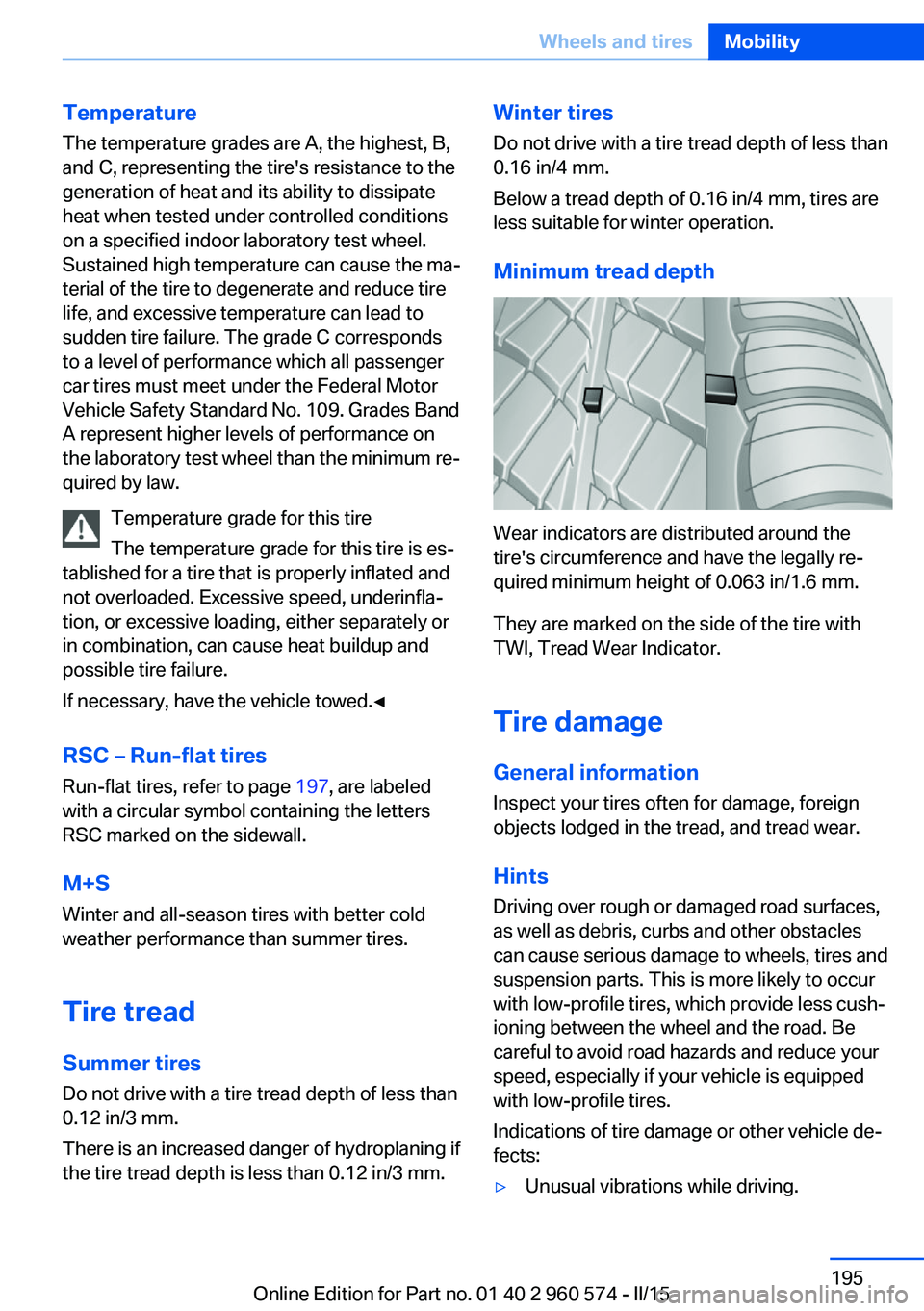
Temperature
The temperature grades are A, the highest, B,
and C, representing the tire's resistance to the
generation of heat and its ability to dissipate
heat when tested under controlled conditions
on a specified indoor laboratory test wheel.
Sustained high temperature can cause the ma‐
terial of the tire to degenerate and reduce tire
life, and excessive temperature can lead to
sudden tire failure. The grade C corresponds
to a level of performance which all passenger
car tires must meet under the Federal Motor
Vehicle Safety Standard No. 109. Grades Band
A represent higher levels of performance on
the laboratory test wheel than the minimum re‐
quired by law.
Temperature grade for this tire
The temperature grade for this tire is es‐
tablished for a tire that is properly inflated and
not overloaded. Excessive speed, underinfla‐
tion, or excessive loading, either separately or
in combination, can cause heat buildup and
possible tire failure.
If necessary, have the vehicle towed.◀
RSC – Run-flat tires Run-flat tires, refer to page 197, are labeled
with a circular symbol containing the letters
RSC marked on the sidewall.
M+S
Winter and all-season tires with better cold
weather performance than summer tires.
Tire tread Summer tires
Do not drive with a tire tread depth of less than
0.12 in/3 mm.
There is an increased danger of hydroplaning if
the tire tread depth is less than 0.12 in/3 mm.Winter tires
Do not drive with a tire tread depth of less than
0.16 in/4 mm.
Below a tread depth of 0.16 in/4 mm, tires are
less suitable for winter operation.
Minimum tread depth
Wear indicators are distributed around the
tire's circumference and have the legally re‐
quired minimum height of 0.063 in/1.6 mm.
They are marked on the side of the tire with
TWI, Tread Wear Indicator.
Tire damage
General information
Inspect your tires often for damage, foreign
objects lodged in the tread, and tread wear.
Hints
Driving over rough or damaged road surfaces,
as well as debris, curbs and other obstacles
can cause serious damage to wheels, tires and
suspension parts. This is more likely to occur
with low-profile tires, which provide less cush‐
ioning between the wheel and the road. Be
careful to avoid road hazards and reduce your
speed, especially if your vehicle is equipped
with low-profile tires.
Indications of tire damage or other vehicle de‐
fects:
▷Unusual vibrations while driving.Seite 195Wheels and tiresMobility195
Online Edition for Part no. 01 40 2 960 574 - II/15
Page 201 of 251
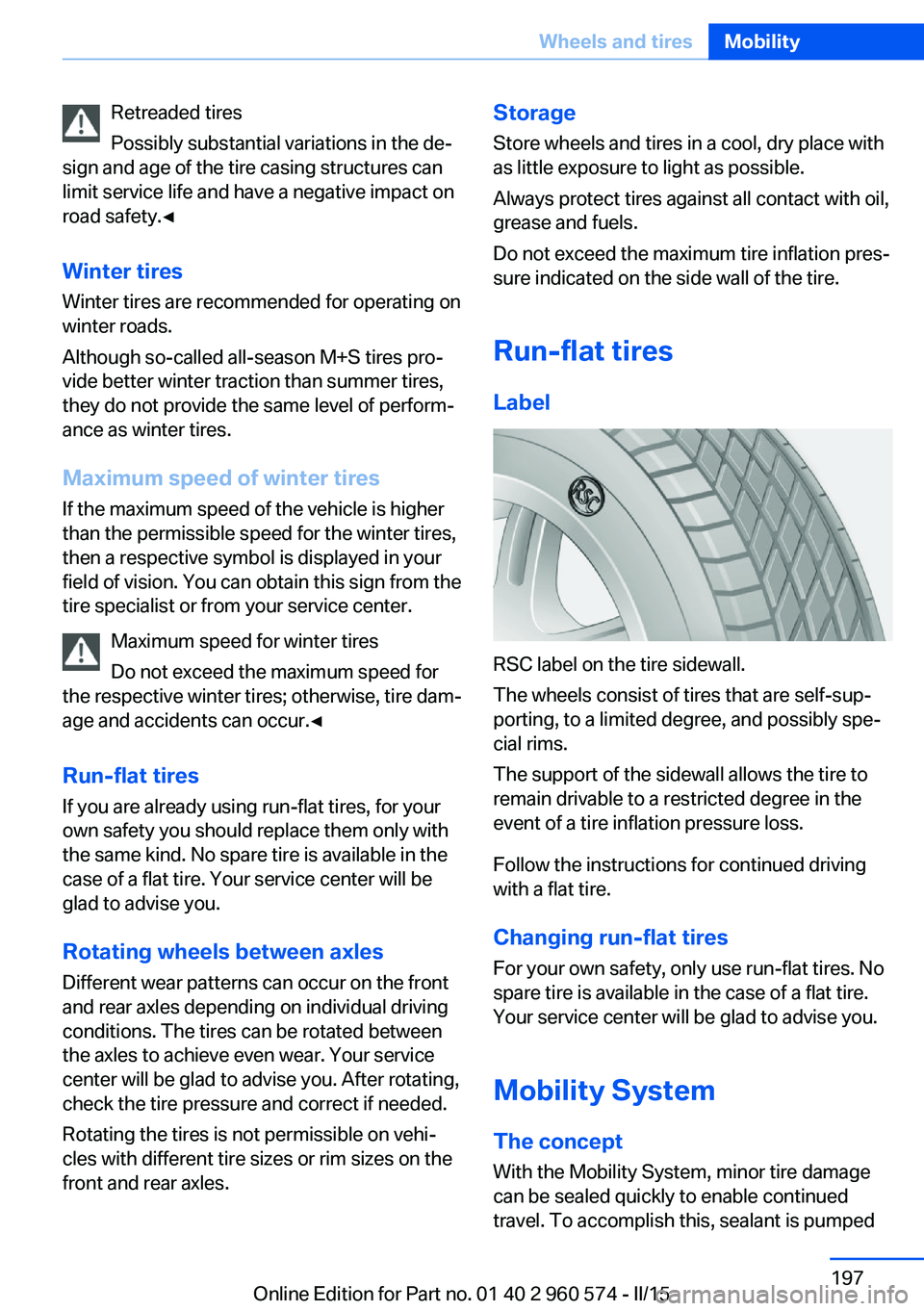
Retreaded tires
Possibly substantial variations in the de‐
sign and age of the tire casing structures can
limit service life and have a negative impact on
road safety.◀
Winter tires
Winter tires are recommended for operating on
winter roads.
Although so-called all-season M+S tires pro‐
vide better winter traction than summer tires, they do not provide the same level of perform‐
ance as winter tires.
Maximum speed of winter tires If the maximum speed of the vehicle is higher
than the permissible speed for the winter tires,
then a respective symbol is displayed in your
field of vision. You can obtain this sign from the
tire specialist or from your service center.
Maximum speed for winter tires
Do not exceed the maximum speed for
the respective winter tires; otherwise, tire dam‐
age and accidents can occur.◀
Run-flat tires If you are already using run-flat tires, for your
own safety you should replace them only with
the same kind. No spare tire is available in the
case of a flat tire. Your service center will be
glad to advise you.
Rotating wheels between axlesDifferent wear patterns can occur on the frontand rear axles depending on individual driving
conditions. The tires can be rotated between
the axles to achieve even wear. Your service
center will be glad to advise you. After rotating,
check the tire pressure and correct if needed.
Rotating the tires is not permissible on vehi‐
cles with different tire sizes or rim sizes on the
front and rear axles.Storage
Store wheels and tires in a cool, dry place with
as little exposure to light as possible.
Always protect tires against all contact with oil,
grease and fuels.
Do not exceed the maximum tire inflation pres‐
sure indicated on the side wall of the tire.
Run-flat tires Label
RSC label on the tire sidewall.
The wheels consist of tires that are self-sup‐
porting, to a limited degree, and possibly spe‐
cial rims.
The support of the sidewall allows the tire to
remain drivable to a restricted degree in the
event of a tire inflation pressure loss.
Follow the instructions for continued driving
with a flat tire.
Changing run-flat tires
For your own safety, only use run-flat tires. No
spare tire is available in the case of a flat tire.
Your service center will be glad to advise you.
Mobility System
The concept With the Mobility System, minor tire damagecan be sealed quickly to enable continued
travel. To accomplish this, sealant is pumped
Seite 197Wheels and tiresMobility197
Online Edition for Part no. 01 40 2 960 574 - II/15
Page 230 of 251
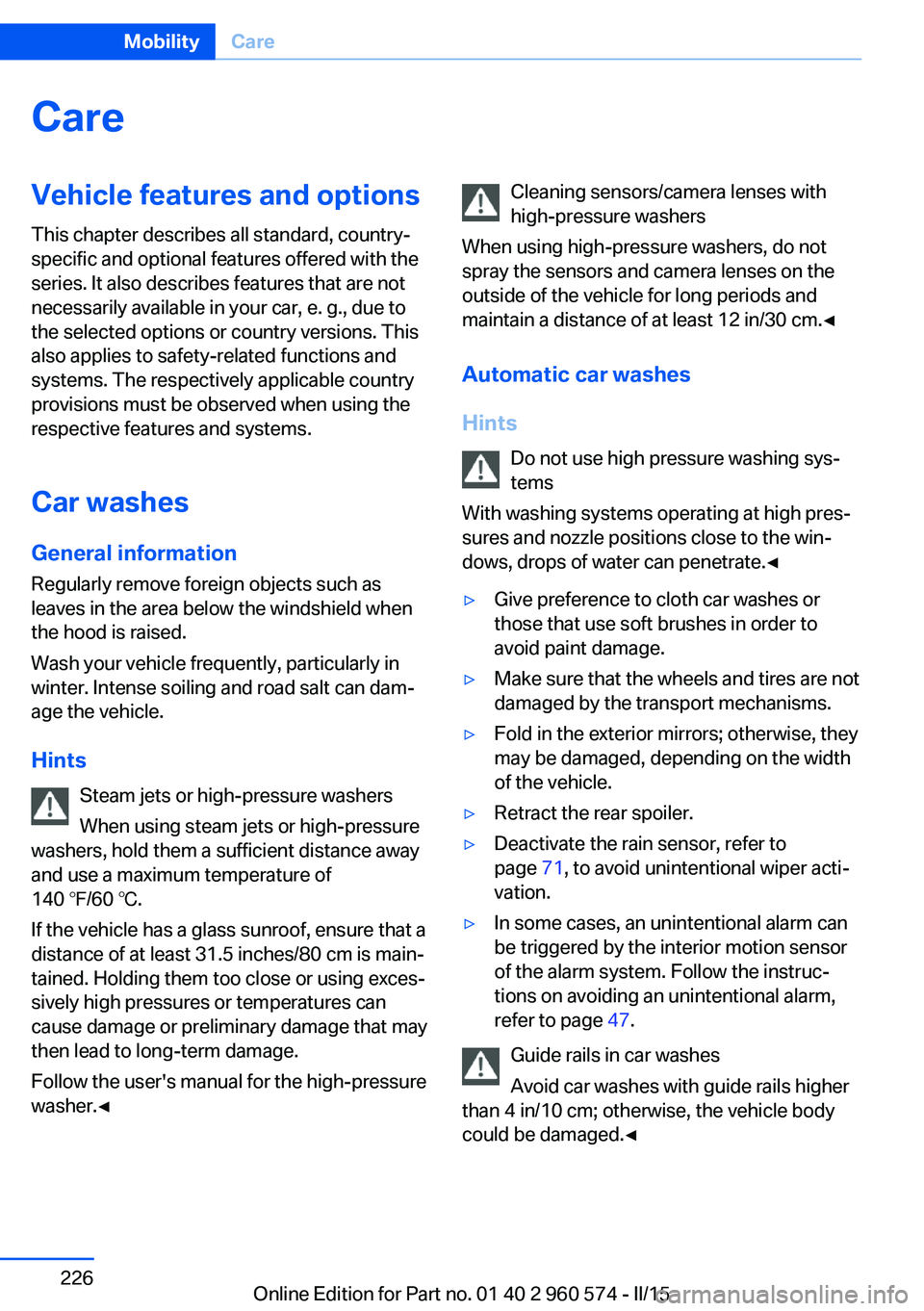
CareVehicle features and optionsThis chapter describes all standard, country-
specific and optional features offered with the
series. It also describes features that are not
necessarily available in your car, e. g., due to
the selected options or country versions. This
also applies to safety-related functions and
systems. The respectively applicable country
provisions must be observed when using the
respective features and systems.
Car washes General information
Regularly remove foreign objects such as
leaves in the area below the windshield when
the hood is raised.
Wash your vehicle frequently, particularly in
winter. Intense soiling and road salt can dam‐
age the vehicle.
Hints Steam jets or high-pressure washers
When using steam jets or high-pressure
washers, hold them a sufficient distance away
and use a maximum temperature of
140 ℉/60 ℃.
If the vehicle has a glass sunroof, ensure that a
distance of at least 31.5 inches/80 cm is main‐
tained. Holding them too close or using exces‐
sively high pressures or temperatures can
cause damage or preliminary damage that may
then lead to long-term damage.
Follow the user's manual for the high-pressure
washer.◀Cleaning sensors/camera lenses with
high-pressure washers
When using high-pressure washers, do not
spray the sensors and camera lenses on the
outside of the vehicle for long periods and
maintain a distance of at least 12 in/30 cm.◀
Automatic car washes
Hints Do not use high pressure washing sys‐
tems
With washing systems operating at high pres‐
sures and nozzle positions close to the win‐
dows, drops of water can penetrate.◀▷Give preference to cloth car washes or
those that use soft brushes in order to
avoid paint damage.▷Make sure that the wheels and tires are not
damaged by the transport mechanisms.▷Fold in the exterior mirrors; otherwise, they
may be damaged, depending on the width
of the vehicle.▷Retract the rear spoiler.▷Deactivate the rain sensor, refer to
page 71, to avoid unintentional wiper acti‐
vation.▷In some cases, an unintentional alarm can
be triggered by the interior motion sensor
of the alarm system. Follow the instruc‐
tions on avoiding an unintentional alarm,
refer to page 47.
Guide rails in car washes
Avoid car washes with guide rails higher
than 4 in/10 cm; otherwise, the vehicle body
could be damaged.◀
Seite 226MobilityCare226
Online Edition for Part no. 01 40 2 960 574 - II/15
Page 245 of 251
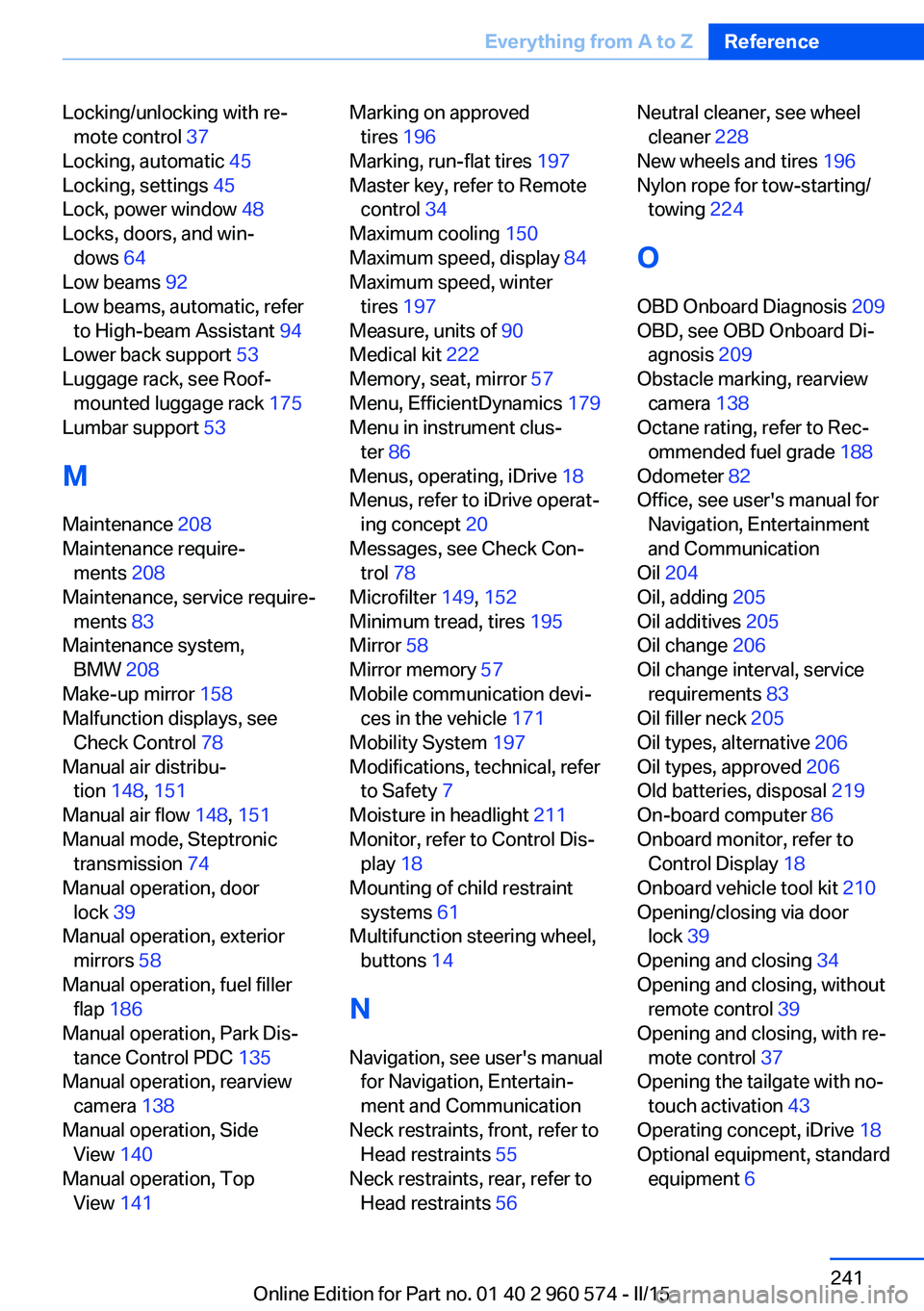
Locking/unlocking with re‐mote control 37
Locking, automatic 45
Locking, settings 45
Lock, power window 48
Locks, doors, and win‐ dows 64
Low beams 92
Low beams, automatic, refer to High-beam Assistant 94
Lower back support 53
Luggage rack, see Roof- mounted luggage rack 175
Lumbar support 53
M
Maintenance 208
Maintenance require‐ ments 208
Maintenance, service require‐ ments 83
Maintenance system, BMW 208
Make-up mirror 158
Malfunction displays, see Check Control 78
Manual air distribu‐ tion 148, 151
Manual air flow 148, 151
Manual mode, Steptronic transmission 74
Manual operation, door lock 39
Manual operation, exterior mirrors 58
Manual operation, fuel filler flap 186
Manual operation, Park Dis‐ tance Control PDC 135
Manual operation, rearview camera 138
Manual operation, Side View 140
Manual operation, Top View 141 Marking on approved
tires 196
Marking, run-flat tires 197
Master key, refer to Remote control 34
Maximum cooling 150
Maximum speed, display 84
Maximum speed, winter tires 197
Measure, units of 90
Medical kit 222
Memory, seat, mirror 57
Menu, EfficientDynamics 179
Menu in instrument clus‐ ter 86
Menus, operating, iDrive 18
Menus, refer to iDrive operat‐ ing concept 20
Messages, see Check Con‐ trol 78
Microfilter 149, 152
Minimum tread, tires 195
Mirror 58
Mirror memory 57
Mobile communication devi‐ ces in the vehicle 171
Mobility System 197
Modifications, technical, refer to Safety 7
Moisture in headlight 211
Monitor, refer to Control Dis‐ play 18
Mounting of child restraint systems 61
Multifunction steering wheel, buttons 14
N
Navigation, see user's manual for Navigation, Entertain‐
ment and Communication
Neck restraints, front, refer to Head restraints 55
Neck restraints, rear, refer to Head restraints 56 Neutral cleaner, see wheel
cleaner 228
New wheels and tires 196
Nylon rope for tow-starting/ towing 224
O OBD Onboard Diagnosis 209
OBD, see OBD Onboard Di‐ agnosis 209
Obstacle marking, rearview camera 138
Octane rating, refer to Rec‐ ommended fuel grade 188
Odometer 82
Office, see user's manual for Navigation, Entertainment
and Communication
Oil 204
Oil, adding 205
Oil additives 205
Oil change 206
Oil change interval, service requirements 83
Oil filler neck 205
Oil types, alternative 206
Oil types, approved 206
Old batteries, disposal 219
On-board computer 86
Onboard monitor, refer to Control Display 18
Onboard vehicle tool kit 210
Opening/closing via door lock 39
Opening and closing 34
Opening and closing, without remote control 39
Opening and closing, with re‐ mote control 37
Opening the tailgate with no- touch activation 43
Operating concept, iDrive 18
Optional equipment, standard equipment 6 Seite 241Everything from A to ZReference241
Online Edition for Part no. 01 40 2 960 574 - II/15
Page 248 of 251
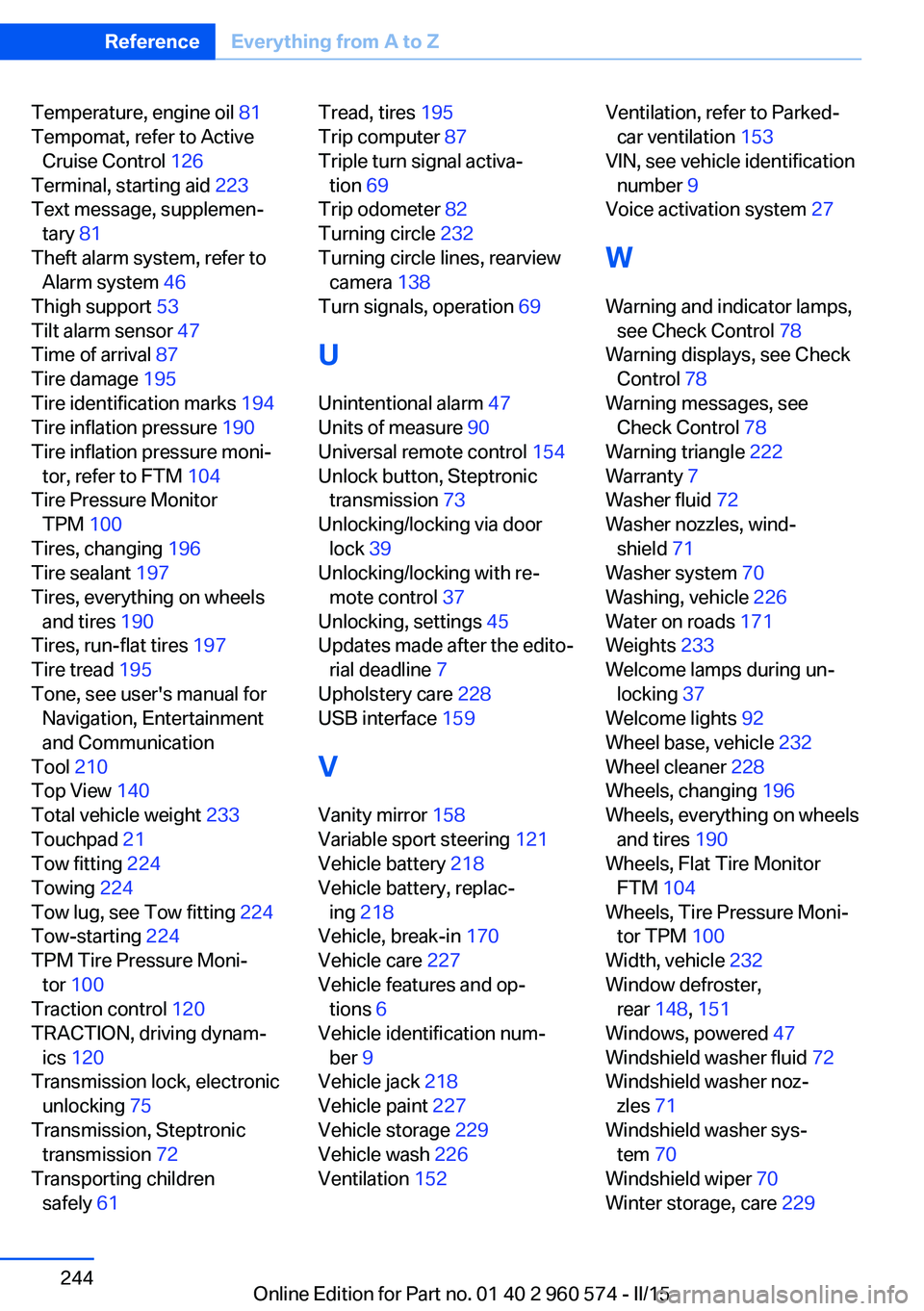
Temperature, engine oil 81
Tempomat, refer to Active Cruise Control 126
Terminal, starting aid 223
Text message, supplemen‐ tary 81
Theft alarm system, refer to Alarm system 46
Thigh support 53
Tilt alarm sensor 47
Time of arrival 87
Tire damage 195
Tire identification marks 194
Tire inflation pressure 190
Tire inflation pressure moni‐ tor, refer to FTM 104
Tire Pressure Monitor TPM 100
Tires, changing 196
Tire sealant 197
Tires, everything on wheels and tires 190
Tires, run-flat tires 197
Tire tread 195
Tone, see user's manual for Navigation, Entertainment
and Communication
Tool 210
Top View 140
Total vehicle weight 233
Touchpad 21
Tow fitting 224
Towing 224
Tow lug, see Tow fitting 224
Tow-starting 224
TPM Tire Pressure Moni‐ tor 100
Traction control 120
TRACTION, driving dynam‐ ics 120
Transmission lock, electronic unlocking 75
Transmission, Steptronic transmission 72
Transporting children safely 61 Tread, tires 195
Trip computer 87
Triple turn signal activa‐ tion 69
Trip odometer 82
Turning circle 232
Turning circle lines, rearview camera 138
Turn signals, operation 69
U Unintentional alarm 47
Units of measure 90
Universal remote control 154
Unlock button, Steptronic transmission 73
Unlocking/locking via door lock 39
Unlocking/locking with re‐ mote control 37
Unlocking, settings 45
Updates made after the edito‐ rial deadline 7
Upholstery care 228
USB interface 159
V Vanity mirror 158
Variable sport steering 121
Vehicle battery 218
Vehicle battery, replac‐ ing 218
Vehicle, break-in 170
Vehicle care 227
Vehicle features and op‐ tions 6
Vehicle identification num‐ ber 9
Vehicle jack 218
Vehicle paint 227
Vehicle storage 229
Vehicle wash 226
Ventilation 152 Ventilation, refer to Parked-
car ventilation 153
VIN, see vehicle identification number 9
Voice activation system 27
W Warning and indicator lamps, see Check Control 78
Warning displays, see Check Control 78
Warning messages, see Check Control 78
Warning triangle 222
Warranty 7
Washer fluid 72
Washer nozzles, wind‐ shield 71
Washer system 70
Washing, vehicle 226
Water on roads 171
Weights 233
Welcome lamps during un‐ locking 37
Welcome lights 92
Wheel base, vehicle 232
Wheel cleaner 228
Wheels, changing 196
Wheels, everything on wheels and tires 190
Wheels, Flat Tire Monitor FTM 104
Wheels, Tire Pressure Moni‐ tor TPM 100
Width, vehicle 232
Window defroster, rear 148, 151
Windows, powered 47
Windshield washer fluid 72
Windshield washer noz‐ zles 71
Windshield washer sys‐ tem 70
Windshield wiper 70
Winter storage, care 229 Seite 244ReferenceEverything from A to Z244
Online Edition for Part no. 01 40 2 960 574 - II/15
Page 249 of 251
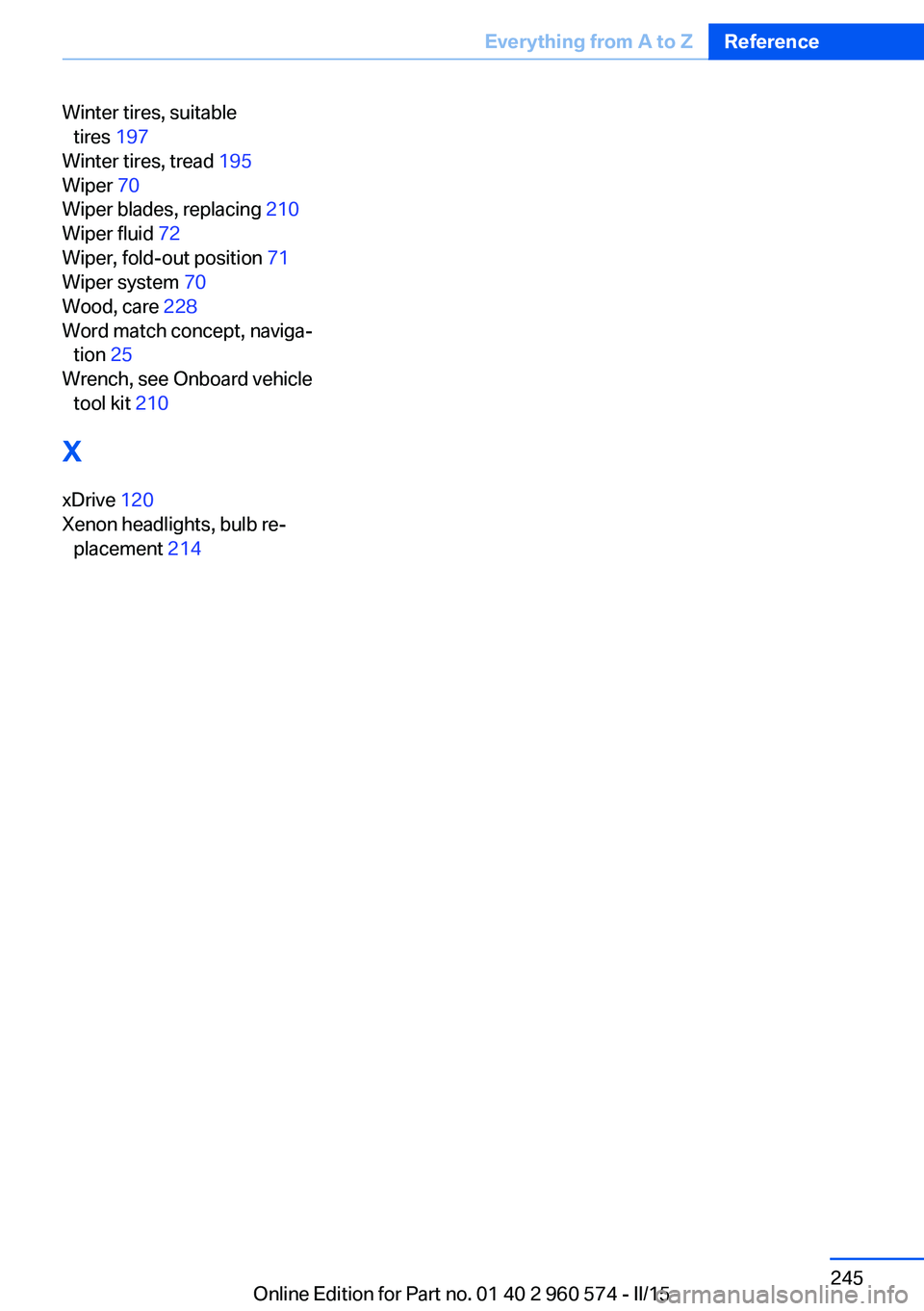
Winter tires, suitabletires 197
Winter tires, tread 195
Wiper 70
Wiper blades, replacing 210
Wiper fluid 72
Wiper, fold-out position 71
Wiper system 70
Wood, care 228
Word match concept, naviga‐ tion 25
Wrench, see Onboard vehicle tool kit 210
X
xDrive 120
Xenon headlights, bulb re‐ placement 214 Seite 245Everything from A to ZReference245
Online Edition for Part no. 01 40 2 960 574 - II/15